Maxgalip AT Tablet 10's
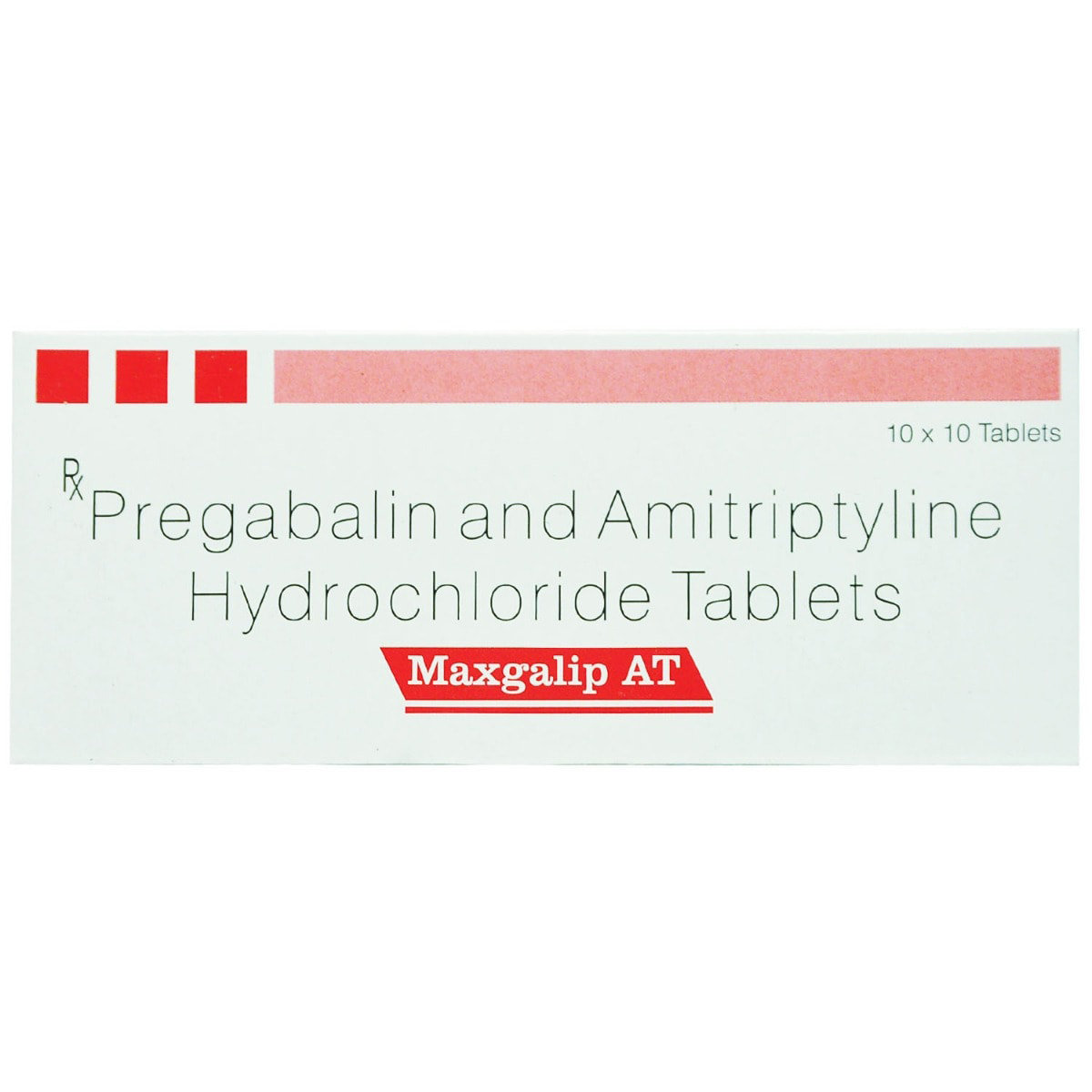
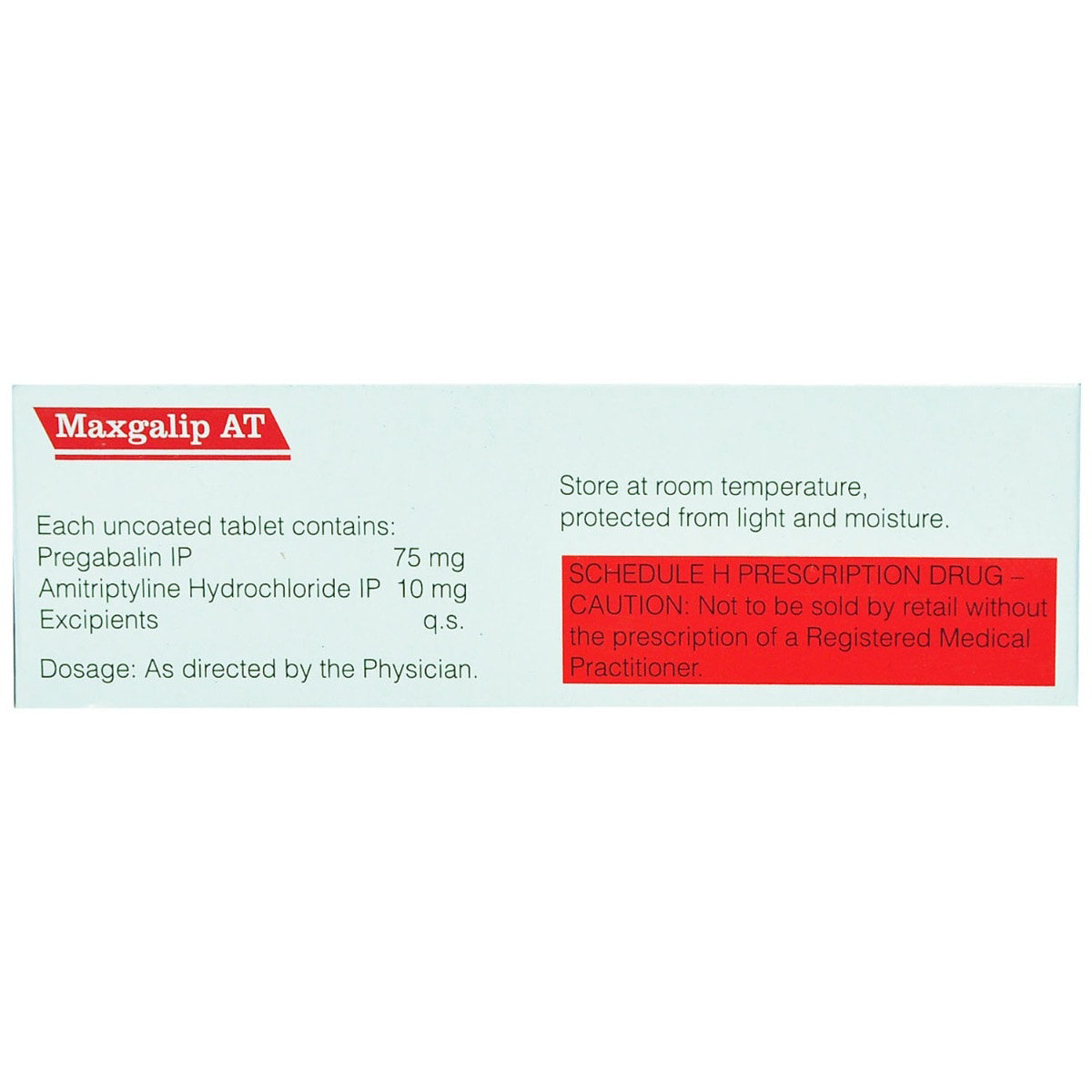
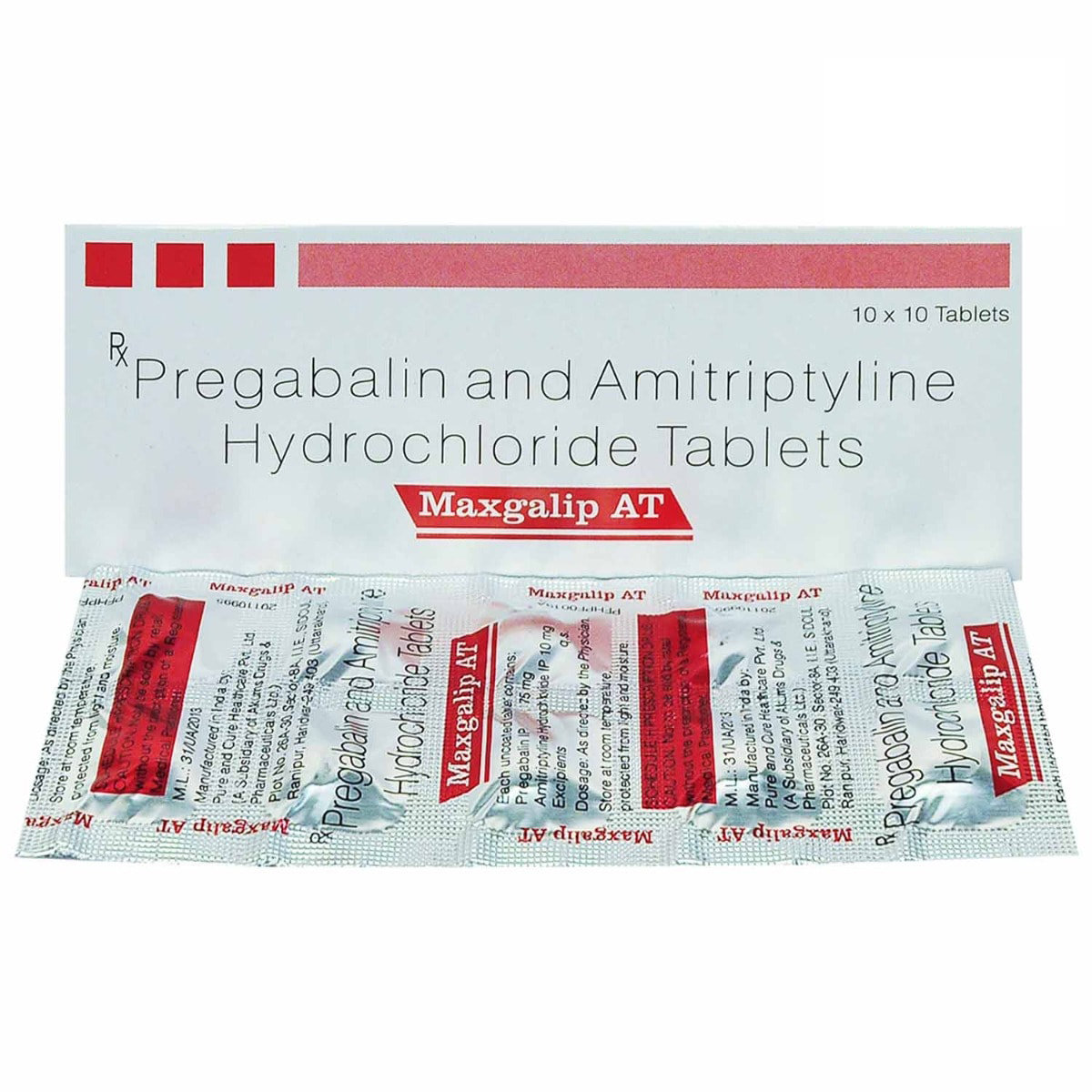







MRP ₹261.5
(Inclusive of all Taxes)
₹39.2 Cashback (15%)
Provide Delivery Location
Online payment accepted
 Prescription drug
Prescription drugWhats That
Composition :
Manufacturer/Marketer :
Consume Type :
Return Policy :
Expires on or after :
About Maxgalip AT Tablet
Maxgalip AT Tablet is a combination medicine indicated for the management of neuropathic pain. Neuropathic pain is a chronic progressive nerve disease which causes nerve pain due to nerve damage or a malfunctioning nervous system. The pain could be intermittent or continuous, which is felt as a prickling, stabbing, tingling or burning sensation.
Maxgalip AT Tablet is a combination of two drugs: Pregabalin (anti-convulsant), and Amitriptyline (antidepressant). Pregabalin works by binding to the specific site on voltage-gated calcium channels; this helps in relieving nerve pain. Amitriptyline increases the level of serotonin and noradrenaline, thereby decreasing the movement of pain receptors. Together, Maxgalip AT Tablet helps to treat neuropathic pain.
You are advised to take Maxgalip AT Tablet for as long as your doctor has prescribed it for you, depending on your medical condition. In some cases, you may experience certain common side-effects such as weight gain, dry mouth, blurred vision, dizziness, tiredness, nausea, vomiting, diarrhoea, and constipation. Most of these side-effects do not require medical attention and will resolve gradually over time. However, you are advised to talk to your doctor if you experience these side-effects persistently.
Consult your doctor if you are pregnant or breastfeeding. Maxgalip AT Tablet may cause drowsiness and dizziness, so drive only if you are alert. Maxgalip AT Tablet should not be given to children as safety and effectiveness have not been established. Avoid consuming alcohol along with Maxgalip AT Tablet as it could lead to increased dizziness and sleepiness. Keep your doctor informed about your health condition and medicines to rule out any side-effects.
Uses of Maxgalip AT Tablet
Directions for Use
Medicinal Benefits
Maxgalip AT Tablet is a combination of two drugs: Pregabalin (anti-convulsant), and Amitriptyline (antidepressant). Pregabalin works by binding to the specific site on voltage-gated calcium channels; this helps in relieving nerve pain. Amitriptyline increases the level of serotonin and noradrenaline, thereby decreasing the movement of pain receptors. Together, Maxgalip AT Tablet helps to treat neuropathic pain.
Storage
- Wear compression garments like stockings, sleeves, or gloves to apply pressure and help stop fluid from building up, especially after the swelling goes down.
- Move around and do exercises to help the fluid circulate, especially in swollen limbs. Ask your doctor for specific exercises.
- Raise the swollen area above your heart level several times a day, even while sleeping, to help reduce swelling.
- Gently massage the swollen area with firm but not painful pressure.
- Keep the swollen area clean and moisturized to prevent injury and infection.
- Reduce salt intake to help prevent fluid from building up and worsening the swelling, as advised by a doctor.
- If the swelling does not get better after a few days of home treatment or worsens, consult your doctor right away.
- Hydrate your body: Drink enough water to prevent dehydration and headaches.
- Calm Your Mind: Deep breathing and meditation can help you relax and relieve stress.
- Rest and Recharge: Sleep for 7-8 hours to reduce headache triggers.
- Take rest: lie down in a quiet, dark environment.
- Cold or warm compresses can help reduce tension.
- Stay Upright: Maintain good posture to keep symptoms from getting worse.
- To treat headaches naturally, try acupuncture or massage therapy.
- Over-the-counter pain relievers include acetaminophen and ibuprofen.
- Prescription Assistance: Speak with your doctor about more substantial drug alternatives.
- Severe Headaches: Seek emergency medical assistance for sudden, severe headaches.
- Frequent Headaches: If you get reoccurring headaches, consult your doctor.
- Headaches with Symptoms: Seek medical attention if your headaches include fever, disorientation, or weakness.
- Include fruits, vegetables, and whole grains in your diet.
- Exercise regularly.
- Quit smoking as it may increase the risk of neuropathy.
- Getting massage therapy and acupuncture might help with pain.
- Avoid massaging the bruise, as this might worsen the damage to the injured tissue.
- Resting the affected area helps prevent more injury and aids healing.
- Place a cloth-wrapped ice pack or cold compress on the affected area for 10 to 15 minutes.
- If the bruise is extensive, severe, or accompanied by other symptoms like warmth, redness, or swelling, get medical help.
- Inform your doctor about dry mouth symptoms. They may adjust your medication regimen or prescribe additional medications to manage symptoms.
- Drink plenty of water throughout the day to help keep your mouth moist and alleviate dry mouth symptoms.
- Chew sugar-free gum or candies to increase saliva production and keep your mouth moisturized.
- Use saliva substitutes, such as mouthwashes or sprays, only if your doctor advises them to help moisturize your mouth and alleviate dry mouth symptoms.
- Avoid consuming smoking, alcohol, spicy or acidic foods, and other irritants that may aggravate dry mouth symptoms.
- Schedule regular dental check-ups to keep track of your oral health and handle any dry mouth issues as they arise.
- Limit your intake of carbonated drinks, alcohol and caffeine as these substances can irritate your bladder.
- Do Kegel exercises to strengthen pelvic floor muscles and improve bladder control.
- Use absorbent pads or underwear to manage accidental urination.
- If incontinence continues or worsens, see a doctor to check for underlying issues.
- Uncoordinated muscle movements need immediate medical attention.
- Observe your movements and try to understand and control the particular movement.
- Regularly do strengthening exercises to improve blood flow throughout the body and avoid involuntary movements.
- Implement massage techniques to enhance blood flow to organs.
- Take a balanced diet and quit smoking.
- Practice yoga and meditation to improve thought processes and reduce uncontrolled and involuntary movements.
Drug Warnings
Do not take Maxgalip AT Tablet if you are allergic to any of its contents; if you have taken MAO inhibitors in the last 14days. Inform your doctor before taking Maxgalip AT Tablet if you have/had heart problems, bipolar syndrome, severe liver disease or porphyria. Consult your doctor if you are pregnant or breastfeeding. Maxgalip AT Tablet may cause drowsiness and dizziness, so drive only if you are alert. Maxgalip AT Tablet should not be given to children as safety and effectiveness have not been established. Avoid consuming alcohol along with Maxgalip AT Tablet as it could lead to increased drowsiness and sleepiness.
Drug-Drug Interactions
Drug-Drug Interactions
Login/Sign Up
Combining Maxgalip AT Tablet and Bepridil may increase the risk of irregular heartbeat.
How to manage the interaction:
Although combining Maxgalip AT Tablet with Bepridil may result in an interaction, it can be used if a doctor recommends it. If you have sudden dizziness, lightheadedness, fainting, or fast or rapid heartbeats during therapy, get emergency medical help. Do not discontinue any medication without consulting a doctor.
The combination of Maxgalip AT Tablet and Potassium chloride may cause stomach and upper intestinal discomfort. (Only applicable to an oral preparation)
How to manage the interaction:
Although co-administration of Maxgalip AT Tablet and Potassium chloride is not recommended as it can possibly lead to an interaction, they can be taken if prescribed by a doctor. If you experience severe stomach pain, bloating, sudden dizziness or lightheadedness, nausea, vomiting (in particular with blood), decreased hunger, and black stools while taking these medications, consult a doctor immediately. Do not discontinue any medications without talking to a doctor.
Combining Maxgalip AT Tablet and Grepafloxacin may increase the risk of irregular heartbeat.
How to manage the interaction:
Although combining Maxgalip AT Tablet with Grepafloxacin may result in an interaction, it can be used if a doctor recommends it. If you have sudden dizziness, lightheadedness, fainting, or fast or rapid heartbeats during therapy, get emergency medical help. Do not discontinue any medication without consulting a doctor. Note: Grepafloxacin is no longer available in the market. Grepafloxacin should not be combined with any other medications.
Combining Maxgalip AT Tablet and Dronedarone may increase the risk of irregular heartbeat.
How to manage the interaction:
Although combining Maxgalip AT Tablet with Dronedarone may result in an interaction, it can be used if a doctor recommends it. If you have any heart problems or electrolyte imbalances, you may be susceptible. If you have sudden dizziness, lightheadedness, fainting, or fast or rapid heartbeats during therapy, get emergency medical help. Do not discontinue any medication without consulting a doctor.
Taking Maxgalip AT Tablet and Ziprasidone may increase the risk of irregular heartbeat.
How to manage the interaction:
Although there is a interaction between Maxgalip AT Tablet with Ziprasidone, but it can be taken together if prescribed by your doctor. However, consult your doctor immediately if you experience sudden dizziness, lightheadedness, fainting, or fast or rapid heartbeats . Do not discontinue any medication without consulting a doctor.
Maxgalip AT Tablet and Thioridazine can enhance each other's effects when used together.
How to manage the interaction:
Although using Maxgalip AT Tablet and Thioridazine together can cause an interaction, they can be used if prescribed by a doctor. If you have extreme sleepiness, confusion, anxiety, vomiting, vision problems, feeling hot or cold, sweating, muscle stiffness, fainting, fits, or coma, seek medical help. Do not discontinue any medications without consulting a doctor.
Combining Maxgalip AT Tablet and Sparfloxacin may increase the risk of irregular heartbeat.
How to manage the interaction:
Although combining Maxgalip AT Tablet with Sparfloxacin may result in an interaction, it can be used if a doctor recommends it. If you have any heart problems or electrolyte imbalances, you may be susceptible. If you have sudden dizziness, lightheadedness, fainting, or fast or rapid heartbeats during therapy, get emergency medical help. Do not discontinue any medication without consulting a doctor. Note: Sparfloxacin is no longer available in the market. Grepafloxacin should not be combined with any other medications.
Combining Furazolidone with Maxgalip AT Tablet can increase the risk of serotonin syndrome(increased serotonin hormone).
How to manage the interaction:
Although using Furazolidone and Maxgalip AT Tablet together may cause an interaction, they can be taken if prescribed by a doctor. Consult a doctor if you have symptoms such as confusion, hallucination, fits, blood pressure alteration, increased heart rate, fever, excessive sweating, shivering or shaking, blurred vision, pain in the muscles or stiffness, incoordination, stomach cramps, nausea, vomiting, and diarrhea. Inform a doctor if you have recently taken Maxgalip AT Tablet. Do not discontinue any medications without consulting a doctor.
Taking Linezolid with Maxgalip AT Tablet can increase the risk of serotonin syndrome (increased serotonin hormone).
How to manage the interaction:
Although using Linezolid and Maxgalip AT Tablet together may cause an interaction, they can be taken if prescribed by a doctor. Consult a doctor if you have symptoms such as confusion, hallucination, fits, blood pressure alteration, increased heart rate, fever, excessive sweating, shivering or shaking, blurred vision, pain in the muscles or stiffness, incoordination, stomach cramps, nausea, vomiting, and diarrhea. Inform a doctor if you have recently taken Maxgalip AT Tablet. Do not discontinue any medications without consulting a doctor.
Combining Maxgalip AT Tablet and Pimozide may increase the risk of irregular heartbeat.
How to manage the interaction:
Although combining Maxgalip AT Tablet with Pimozide may result in an interaction, it can be used if a doctor recommends it. If you have any heart problems or electrolyte imbalances, you may be susceptible. If you have sudden dizziness, lightheadedness, fainting, or fast or rapid heartbeats during therapy, get emergency medical help. Do not discontinue any medication without consulting a doctor.
Drug-Food Interactions
Drug-Food Interactions
Login/Sign Up
Diet & Lifestyle Advise
- Include food rich in vitamin B and D in your diet.
- Include cayenne pepper in your diet as it can help in lowering neuropathic pain.
- Exercising regularly helps in improving overall health and combating pain.
- Rest well, and get plenty of sleep.
- Try taking a warm bath, as it can be soothing.
- Avoid smoking and alcohol consumption.
- Meditation and yoga can help lower stress, decrease pain sensitivity and improves coping skills.
- Acupuncture can be helpful by stimulating pressure points.
- Using essential oils for massages can help increase circulation.
Side Effects of Maxgalip AT Tablet
- Weight gain
- Dry mouth
- Blurred vision
- Dizziness
- Tiredness
- Nausea
- Vomiting
- Diarrhoea
- Constipation
Habit Forming
Therapeutic Class
All Substitutes & Brand Comparisons
RX
Out of StockNot for online saleStayHappi Amitriptyline+Pregabalin 10mg/75mg Tablet
₹99
(₹8.91 per unit)
62% CHEAPERRX
Out of StockNeugalin A 10mg/75mg Tablet
Shasun Pharmaceuticals Ltd
₹147
(₹13.23 per unit)
43% CHEAPERRX
Not for online saleCobaleo AM-P Tablet 10's
Win Life Science Pvt Ltd
₹168.5
(₹15.17 per unit)
35% CHEAPER
Product Substitutes
Author Details
We provide you with authentic, trustworthy and relevant information
Drug-Diseases Interactions
Drug-Diseases Interactions
Login/Sign Up
FAQs
Maxgalip AT Tablet contains Pregabalin and Amitriptyline. Pregabalin works by binding to the specific site on voltage-gated calcium channels; this helps in relieving nerve pain. Amitriptyline increases the level of serotonin and noradrenaline, thereby decreasing the movement of pain receptors. Together, Maxgalip AT Tablet helps to treat neuropathic pain.
Maxgalip AT Tablet may cause weight gain due to an increase in appetite. Maintain a healthy weight by regular exercise and following a proper diet.
Dry mouth could be a side-effect of Maxgalip AT Tablet . Limiting caffeine intake, avoiding smoking and mouthwashes containing alcohol, drinking water regularly, and chewing sugar-free gum/candy might stimulate saliva and prevent drying of the mouth.
To treat your condition effectually, continue taking Maxgalip AT Tablet for as long as prescribed. Do not be reluctant to speak with your doctor if you feel any difficulty while taking Maxgalip AT Tablet ; your doctor will reduce the dose gradually.
Maxgalip AT Tablet is used to treat neuropathic pain due to diabetic neuropathy. Diabetic neuropathy is a condition in which nerve damage occurs due to high blood glucose levels. It mostly damages the nerves in legs and feet.
Maxgalip AT Tablet may cause sexual disturbances such as decreased sex drive and problems with erection. Consult your doctor if you have any concerns regarding this.
Drug-Drug Interactions Checker List
- DULOXETINE
- SERTRALINE
- ESCITALOPRAM
- FENTANYL
- HYDROCODONE
- ACETAMINOPHEN
- MORPHINE
- OXYCODONE
- TOPIRAMATE
- ALPRAZOLAM
- ZOLPIDEM
- DIPHENHYDRAMINE
- CETIRIZINE
- CYCLOBENZAPRINE
- LEVOTHYROXINE
Disease/Condition Glossary
Neuropathic pain: Neuropathic pain is caused due to damage to sensory nerves. It is caused by chronic progressive nerve disease or due to infection or injury. The pain could be intermittent or continuous, which is felt as a prickling, stabbing, tingling or burning sensation. A feeling of numbness and loss of sensations is also common with neuropathic pain. Usually, the body sends the pain signals when there is an injury, but with neuropathic pain, the pain is not triggered by an injury; the body unpromptedly sends the pain signals. Symptoms include spontaneous, untriggered pain, unpleasant feeling, shooting, burning or stabbing pain, difficulty resting or sleeping, and evoked pain (pain caused by events usually not painful).

Have a query?
Buy best C.n.s Drugs products by
Intas Pharmaceuticals Ltd
Sun Pharmaceutical Industries Ltd
Torrent Pharmaceuticals Ltd
Alkem Laboratories Ltd
Abbott India Ltd
Cipla Ltd
Alteus Biogenics Pvt Ltd
Micro Labs Ltd
Lupin Ltd
Ipca Laboratories Ltd
D D Pharmaceuticals Pvt Ltd
Icon Life Sciences
Mankind Pharma Pvt Ltd
Tripada Healthcare Pvt Ltd
Arinna Lifesciences Ltd
Linux Laboratories Pvt Ltd
East West Pharma India Pvt Ltd
La Renon Healthcare Pvt Ltd
Talent India Pvt Ltd
Tas Med India Pvt Ltd
Zydus Healthcare Ltd
Cnx Health Care Pvt Ltd
Eris Life Sciences Ltd
Leeford Healthcare Ltd
Emcure Pharmaceuticals Ltd
Macleods Pharmaceuticals Ltd
Sigmund Promedica
Aristo Pharmaceuticals Pvt Ltd
Dr Reddy's Laboratories Ltd
Troikaa Pharmaceuticals Ltd
Consern Pharma Ltd
Zydus Cadila
Shine Pharmaceuticals Ltd
Wockhardt Ltd
Ardent Life Sciences Pvt Ltd
Crescent Formulations Pvt Ltd
Theo Pharma Pvt Ltd
Reliance Formulation Pvt Ltd
Ikon Pharmaceuticals Pvt Ltd
Propel Healthcare
Neon Laboratories Ltd
Jagsam Pharma
Msn Laboratories Pvt Ltd
Morepen Laboratories Ltd
Pulse Pharmaceuticals
Sanofi India Ltd
Med Manor Organics Pvt Ltd
Hetero Healthcare Pvt Ltd
Novartis India Ltd
Crescent Therapeutics Ltd
Elder Pharmaceuticals Ltd
Solvate Laboratories Pvt Ltd
Akumentis Healthcare Ltd
Mova Pharmaceutical Pvt Ltd
Psyco Remedies Ltd
Tripada Lifecare Pvt Ltd
Ajanta Pharma Ltd
Cyrus Remedies Pvt Ltd
Medishri Healthcare Pvt Ltd
Cadila Healthcare Ltd
Glenmark Pharmaceuticals Ltd
Matteo Health Care Pvt Ltd
Hbc Life Sciences Pvt Ltd
Lyf Healthcare
Matias Healthcare Pvt Ltd
Mesmer Pharmaceuticals
Alembic Pharmaceuticals Ltd
Capital Pharma
Crescent Pharmaceuticals
Medopharm Pvt Ltd
Alniche Life Sciences Pvt Ltd
Kivi Labs Ltd
Talin Remedies Pvt Ltd
USV Pvt Ltd
Quince Lifesciences Pvt Ltd
Solis Pharmaceuticals
Infivis Life Care
Zuventus Healthcare Ltd
Cadila Pharmaceuticals Ltd
Pfizer Ltd
Wallace Pharmaceuticals Pvt Ltd
A N Pharmacia Laboratories Pvt Ltd
Blue Cross Laboratories Pvt Ltd
Jenburkt Pharmaceuticals Ltd
Lia Life Sciences Pvt Ltd
Mano Pharma
Medley Pharmaceuticals Ltd
Primus Remedies Pvt Ltd
FDC Ltd
Maneesh Pharmaceuticals Ltd
Apex Laboratories Pvt Ltd
Gagnant Healthcare Pvt Ltd
Ozone Pharmaceuticals Ltd
RPG Life Sciences Ltd
Strides Shasun Ltd
Unichem International
GlaxoSmithKline Pharmaceuticals Ltd
Kuresys Labs Pvt Ltd
LA Pharma
Trion Pharma India Llp
Alcohol
Unsafe
Avoid consumption of alcohol while taking Maxgalip AT Tablet as it may increase drowsiness and sleepiness.
Pregnancy
Caution
Please consult your doctor if you have any concerns regarding this, your doctor will prescribe only if the benefits outweigh the risks.
Breast Feeding
Caution
Consult your doctor before taking Maxgalip AT Tablet ; your doctor will decide whether Maxgalip AT Tablet can be taken by breastfeeding mothers or not.
Driving
Unsafe
Maxgalip AT Tablet may cause drowsiness, sleepiness and blurred vision. Do not drive or operate machinery unless you are alert.
Liver
Caution
Dose adjustment may be needed in patients with liver impairment. Please consult your doctor if you have a liver impairment or any concerns regarding this.
Kidney
Caution
Dose adjustment may be needed in patients with kidney impairment. Please consult your doctor if you have kidney impairment or any concerns regarding this.
Children
Caution
Maxgalip AT Tablet should not be given to children as the safety and efficacy have not been established.



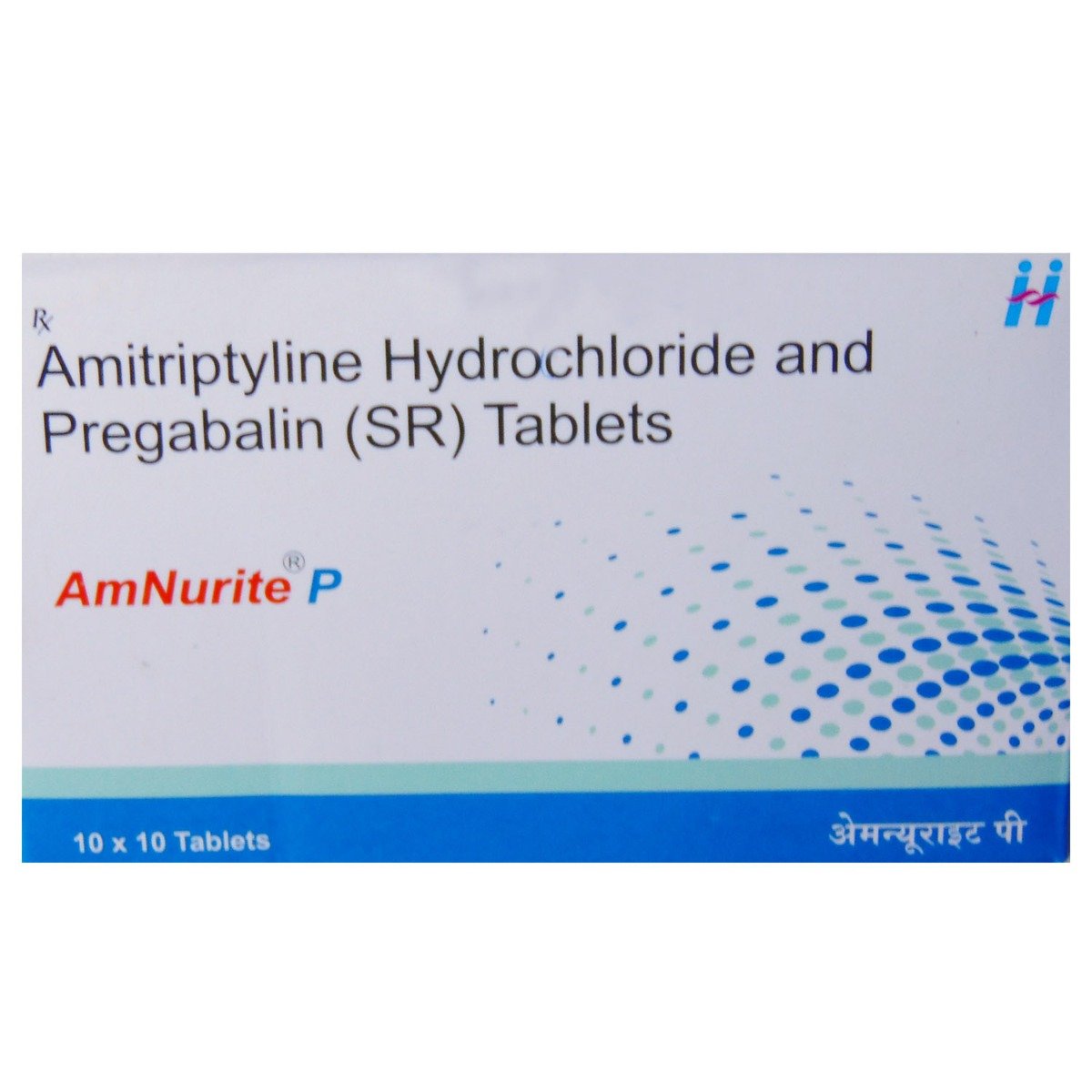

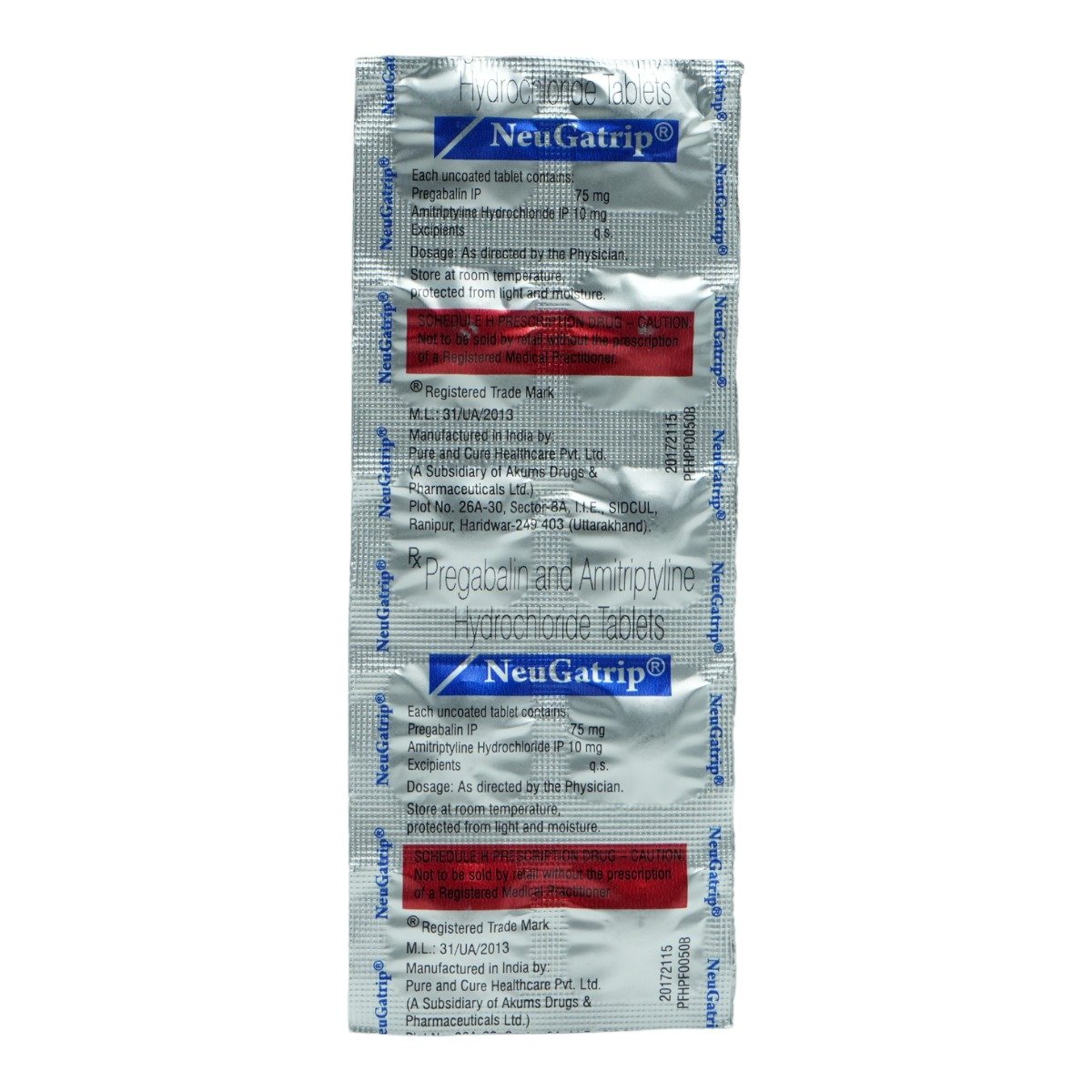


_0.jpg?tr=q-85)

